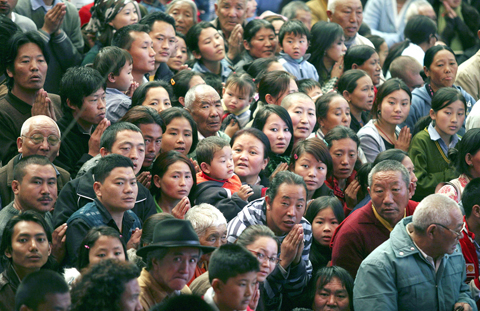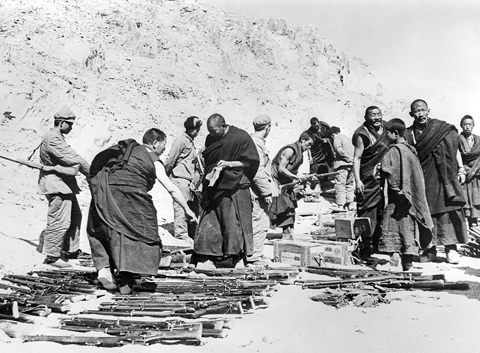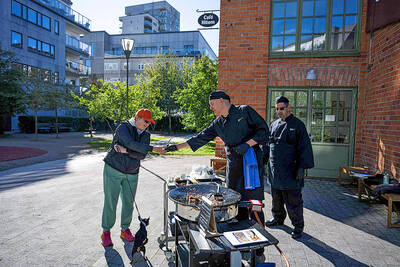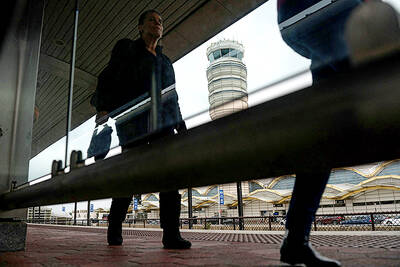Amid growing anger among Tibetan exiles at China’s subjugation of Tibet and its monasteries, bitter memories of a failed armed struggle haunt former guerrilla fighter Lhasang Tsering.
Over five decades, the Tibetan movement has drawn international attention and support for being among the world’s rare non-violent struggles, which has been credited to the Dalai Lama’s “middle way” approach, which stresses conciliatory negotiations with China.
Although the policy has made little headway with Beijing, the Dalai Lama was awarded the Nobel Peace Prize in 1989 for leading Tibet’s non-violent struggle.

PHOTO: AP
Against such a backdrop, 15 years of a violent conflict for Tibetan independence beginning in the late 1950s is looked at as a “deviation” that many Tibetans do not like to talk about.
With the passage of time and the fighters fading into congested refugee settlements, the episode has nearly been forgotten and is spoken about only in hushed tones.
But for Tsering, the armed struggle is as real as the day he joined it in northern Nepal’s Mustang district in 1972.

PHOTO: AFP
Among the prominent dissidents of the Tibetan diaspora, Tsering once worked with the Tibetan government-in-exile but resigned in 1990 to protest the Dalai Lama’s decision to give up the demand for an independent Tibet in favor of seeking autonomy within China.
A slight man with a goatee, Tsering, who also headed the Tibetan Youth Congress, has for decades criticized the middle way policy of the Dalai Lama.
“From my moral standpoint, the non-violence in surrendering to an evil is far worse than the use of violence to overcome the evil,” said Tsering, who now runs a bookshop in Mcleodganj, a suburb of Dharamsala, India.
If Tibetans do not defend themselves against a “colonial China,” they would one day disappear like the Inca civilization in South America, said the former fighter, who is now in his mid-50s.
The armed resistance against the Chinese began after the invasion of Tibet’s eastern Kham and Amdo regions by the People’s Liberation Army in the 1950s.
The Khampa fighters of the region announced the formation in 1958 of the Chushi Gangdruk — which means “four rivers, six ranges” and refers to Kham — to stop the Chinese army’s advance into Lhasa.
When the March 10, 1959, uprising against the Chinese failed, the Gangdruk guerrillas helped the Dalai Lama flee to India, Tsering said, adding that the fighters then retreated to Mustang, from where they conducted raids into Tibet and waged war with the Chinese army for 15 years.
At its peak, the force consisted of an estimated 2,000 Tibetans and received support like arms, ammunition and training from the CIA.
“We were certainly few to win against the Chinese but enough to create a lot of problems for them,” he said.
But with the US government’s rapprochement with China, aid and supplies from the CIA began to wane in the late 1960s. Nepalese troops also began a crackdown to crush the fighters.
Chushi Gangdruk’s operations finally ceased in 1974 after the Dalai Lama taped a message telling the fighters to lay down their weapons and surrender.
“The fighters could not say no to the Dalai Lama, but several committed suicide as they had vowed to fight to the bitter end,” Tsering said, choked with emotion and with tears in his eyes. “They could find freedom and dignity only in death.”
Others were arrested, killed or escaped.
Tsering still justified an armed struggle for his homeland and said he would be ready to put his “life on the line” were there an opportunity.
“It takes two to shake hands, but the Chinese found no need to shake hands with a bunch of helpless refugees,” he said, adding as an afterthought: “It takes only one to deliver a punch.”
Tsering said the exiled Tibetans have been confused and frustrated with talks with China because their movement lacks clarity of purpose. Frustration has also grown after the lack of progress after 50 years of exile following the flight of the Dalai Lama from Tibet on March 17, 1959.
Mentioning that Tibetans in Tibet were sacrificing their lives for independence, Tsering pointed toward the residence of the Dalai Lama and said: “If only the holy one would restore clarity of purpose and return to the cause of freedom.”
“He is our spiritual leader, and Tibetans are not in a position where they can question His Holiness, but to force Tibetans to choose between freedom and faith is not right,” Tsering said.

READINESS: According to a survey of 2,000 people, 86 percent of Swedes believe the country is worth defending in the event of a military attack Swedes are stocking up on food items in case of war, as more conflict in Europe no longer feels like a distant possibility, and authorities encourage measures to boost readiness. At a civil preparedness fair in southwest Stockholm, 71-year-old Sirkka Petrykowska said that she is taking the prospect of hostilities seriously and preparing as much as she can. “I have bought a camping stove. I have taken a course on preservation in an old-fashioned way, where you can preserve vegetables, meat and fruit that lasts for 30 years without a refrigerator,” Petrykowska said. “I’ve set aside blankets for warmth, I

FRUSTRATIONS: One in seven youths in China and Indonesia are unemployed, and many in the region are stuck in low-productivity jobs, the World Bank said Young people across Asia are struggling to find good jobs, with many stuck in low-productivity work that the World Bank said could strain social stability as frustrations fuel a global wave of youth-led protests. The bank highlighted a persistent gap between younger and more experienced workers across several Asian economies in a regional economic update released yesterday, noting that one in seven young people in China and Indonesia are unemployed. The share of people now vulnerable to falling into poverty is now larger than the middle class in most countries, it said. “The employment rate is generally high, but the young struggle to

ENERGY SHIFT: A report by Ember suggests it is possible for the world to wean off polluting sources of power, such as coal and gas, even as demand for electricity surges Worldwide solar and wind power generation has outpaced electricity demand this year, and for the first time on record, renewable energies combined generated more power than coal, a new analysis said. Global solar generation grew by a record 31 percent in the first half of the year, while wind generation grew 7.7 percent, according to the report by the energy think tank Ember, which was released after midnight yesterday. Solar and wind generation combined grew by more than 400 terawatt hours, which was more than the increase in overall global demand during the same period, it said. The findings suggest it is

IN THE AIR: With no compromise on the budget in sight, more air traffic controllers are calling in sick, which has led to an estimated 13,000 flight delays, the FAA said Concerns over flight delays and missed paychecks due to the US government shutdown escalated on Wednesday, as senators rejected yet another bid to end the standoff. Democrats voted for a sixth time to block a Republican stopgap funding measure to reopen government departments, keeping much of the federal workforce home or working without pay. With the shutdown in its eighth day, lines at airports were expected to grow amid increased absenteeism among security and safety staff at some of the country’s busiest hubs. Air traffic controllers — seen as “essential” public servants — are kept at work during government shutdowns, but higher numbers